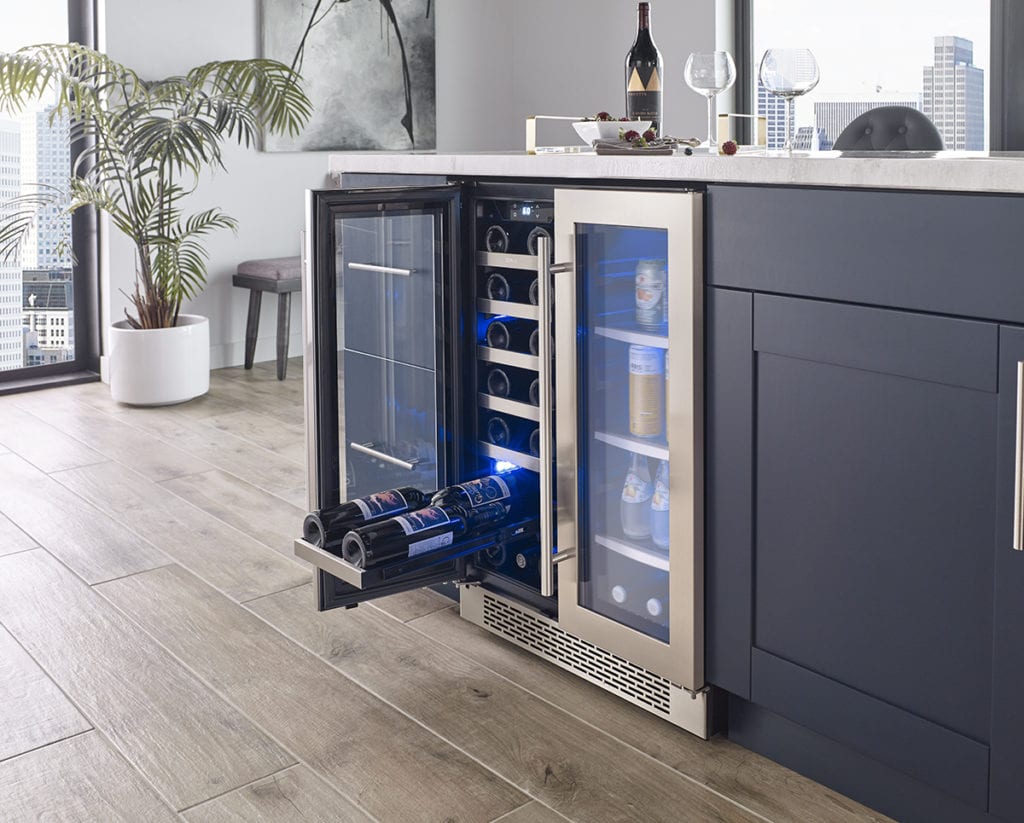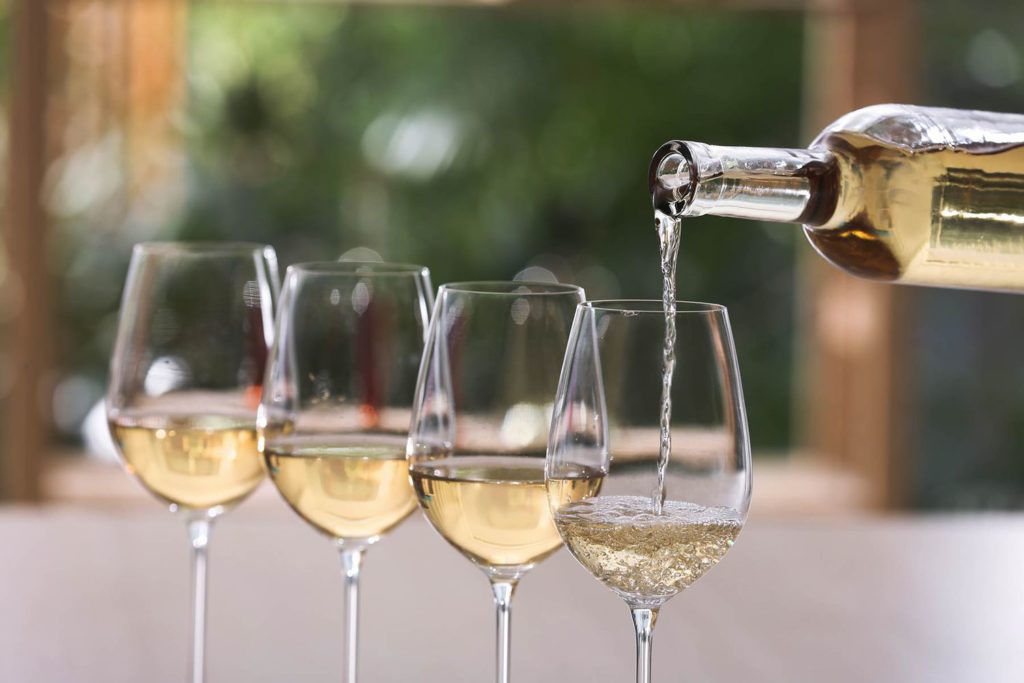Wine’s temperature has an impact on its flavor and aids in appropriate wine aging. If you have a good cooler, it’s not that difficult to maintain the ideal temperature for dual-zone wine fridge.
Coolers come in a variety of varieties on the marketplace currently. Knowing how the various items supplied differ from one another and paying close attention to details are essential.
Before understanding the ideal temperature for dual zone wine cooler, let’s learn some basic things about ideal storing wine temperature, ideal serving wine temperatures, and the difference between them.
What Temperature is Best for Storing Wine?
A study in 2014 confirmed that the temperature and humidity of wine storage impact its quality.
Storing wine can be simple if you follow the example of a traditional cellar found in a basement or an old brick mansion in a vineyard in Tuscany. They don’t have separate chambers for each type of wine, and each chamber doesn’t have a different storage temperature.
According to their traditional methods, all wines are stored in the same cellar under the same temperature. This means that you should also store your wine similarly.
In fact, all types of wines such as red wine, white wine, sparkling wine, etc can be stored at the same temperatures, which are between 53.6°F and 57.2 °F (~12°C to 14°C).

Storing wine at temperatures below this risks stunting their maturation, while keeping them at too warm temperatures will cause premature aging.
Ideal Storage Temperature vs Ideal Serving Temperature
It is important to distinguish between the storage and serving temperatures of your wine collection. While all wines should be stored within the temperature range of 53.6 °F – 57.2 °F (12°C – 14°C), different types of wine require different serving temperatures.
Wines have different temperature requirements for optimal flavor and aroma expression. Reds should be served at higher temperatures while whites, sparkling, and rosé wines should be chilled.
It can be confusing to pick the right storage temperature for your wine bottles because reds and whites require different serving temperatures, and the storage temperature is not the same as the serving temperature. What’s the solution?
What Temperature is Ideal for Serving Wine?
It’s important to store all wines in the same temperature range, but serving temperatures may vary depending on the type.
For wines that taste better at room temperature, you’ll need to warm them up. For those that taste better chilled, you’ll need to keep them cool.
Pro Tip: Lighter wines should be served colder.
This is why wine refrigerators are helpful, particularly those with multiple cooling zones, such as a dual-zone wine fridge. These fridges have two sections with different temperatures that can be independently controlled.
This means you can use dual-zone wine coolers to maintain different sections at the ideal serving temperature for red and white wines.
Wine collectors may choose to store their wines long-term in one section and use another section for serving their wines.
So what is the ideal temperature range for serving wine in a wine cooler?
Serving Temperatures for Red Wine
Serving red wines at room temperature is ideal. Warming the liquid brings out all the nutty and fruity qualities that red wine is known for.
Red wine should indeed be served between 62°F and 68°F (16.6°C – 20°C).
If you do not have a wine fridge, reheat the wine for 30 minutes if you stored it in the fridge or chill it for 30 mins in your standard refrigerator if you left it at room temperature.

Serving Temperatures for White Wine
White wine, in contrast to red wine, benefits from cooling. White wine is typically reviving, used regularly in cocktails, and goes perfectly with a variety of light foods.
Serving temperatures for white wine should range from 49°F to 55°F (9.5°C – 12.8°C).
Keep in mind that one ought not to be served with ice. Just be sure to fully cool this before serving and maintain it at serving temperature by storing it in a wine bucket with ice.

Serving Temperatures for Sparkling Wine
The majority of sparkling wines are served at the same temperature as Champagne.
The coldest of all serving temperatures for champagne is between 46.4°F and 50°F (8°C – 10°C).
Never chill wine in the freezer if you don’t have a wine cooler, since the bubbles might break the bottle. The bottle can be chilled for four hours in the bottom drawer of your refrigerator or for 30 minutes in a wine bucket.
What are the ideal temperatures for single-zone and dual-zone wine fridges?
What is the intended use of your wine fridge? Are you using it to store your wine collection or to chill wine for serving purposes? The ideal temperature will vary based on your specific purpose.
Here are your options for wine fridge temperatures, along with the recommended temperatures.
Single Zone Wine Fridge Temperature Settings
A single-zone wine fridge has the ability to maintain a consistent temperature throughout its interior.
You must select a temperature and all the wine bottles stored inside will be kept at the same temperature.
It is recommended to set the ideal temperature of a single-zone wine fridge between 53.6 °F and 57.2 °F (12°C – 14°C).
The recommended storage temperature for all wines is this one. Depending on the type of wine you prefer, you can easily chill or warm up a bottle from here.
If you want to maintain the serving temperature of your wine bottles, use the temperature ranges provided above to identify the ideal temperature for your needs.
To summarize, a single-zone wine refrigerator can be useful for:
- Storing all types of wines
- Preparing a particular type of wine for serving.
Ideal Temperature for Dual Zone Wine Fridge
A dual-zone wine cooler is a refrigerator that is specifically designed to store different types of wine at two different temperatures.
It is ideal for those who want to enjoy both red and white wines as it allows you to store each variety at the exact temperature they need in order to preserve their flavor, aroma, and bouquet.

The two separate compartments in the dual-zone wine cooler can be set to different temperatures, making it easy to chill both white and red wines at the same time.
They also typically feature adjustable shelves and racks that allow you to store your bottles horizontally or vertically.
A dual-zone wine fridge is very versatile as it allows you to store and chill or warm up bottles in the same appliance. In most dual-zone wine coolers, there is a compartment that needs to be kept warmer than the other, usually the lower zone.
However, this isn’t always the case, and the manual will provide instructions on which compartment should be warmer and how much temperature difference is allowed between the zones.
For those who drink red wine
For those who drink red wine, it is recommended to store the bottles in two zones.
One zone should be set at storage temperature between 53.6 °F and 57.2 °F (12°C – 14°C), and the other zone at serving temperature between 62 °F and 68 °F (16.6 °C – 20°C).
Before drinking, remember to move the bottle from the storage zone to the warming zone at least a few hours in advance.
For those who drink white wine
To properly store and serve white wines, use a wine refrigerator with two temperature zones.
Set one zone to a storage temperature range of 53.6°F to 57.2°F (12°C – 14°C), and the other zone to a lower serving temperature range of 49°F to 55°F (9.5°C – 12.8°C).
Since there is some overlap between the two temperature ranges, white wines can be conveniently stored in this type of refrigerator.
Similar to red wines, move the bottle from the storage zone to the serving zone a few hours before serving.
For those who are fans of both red and white wines
Do you like red and white equally? To keep your beverages separate, set the areas at a temperature that is somewhat higher (for reds) or lower (for whites) than the standard storage temperature.
The optimal temperature for wine storage is between 53.6°F and 57.2°F (12°C – 14°C), so keep that in mind.
Set the temperature for the white to the lower end of the range, around 53 °F (11.6°C).
Regarding the reds, the bottles are kept closer to the serving temperature of (62 °F to 68 °F) (16.6 °C – 20°C) by keeping the highest storage temperature range at roughly 57 °F (13.8°C).
The ideal temperatures for wine fridges according to various wine styles
To store different wine styles properly, here are the optimal temperatures:
- Fortified wines like Port and Madeira, whether sweet or dry, should be stored at 66°F (19°C).
- Full-bodied red wines like Shiraz and Cabernet Sauvignon are best stored at 63°F-64°F (17°C-18°C) to bring out their best qualities.
- Light to medium-bodied red wines such as Merlot and Pinot Noir taste great when stored at 54°F-61°F (12°C-16°C).
- Full-bodied white wine like Chardonnay is best kept at 50°F (10°C).
- Light to medium-bodied white wines such as Riesling, Pinot Gris, and Sauvignon Blanc should be stored at 46°F-48°F (8°C-9°C).
- Sparkling and dessert wines taste best when stored at 41°F-46°F (5°C-8°C).
Keep These Tips in Mind While Using a Wine Fridge
According to wine experts, here are some tips you need to do to keep your wine fridge run smoothly and has a long life span:
- Tip 1: Location: Make sure to find a spot for your wine fridge that is away from sources of direct heat and humidity. Sunlight can also be damaging to the wines, so avoid direct sunlight as much as possible.
- Tip 2: Temperature: The temperature of the wine fridge should be set between 45-55 degrees Fahrenheit (7-13 C). This will help keep your wines at the optimal level of flavor and aroma.
- Tip 3: Humidity Levels: Keeping your wine fridge at a relative humidity of around 50% is also important for preserving the flavor and aroma of your wines.
- Tip 4: Storage: When storing wines in a wine fridge, make sure to use shelves or racks that are designed for this purpose. This will help prevent bottles from leaking or breaking as well as keep them from rolling around inside the fridge.
- Tip 5: Power Supply: Make sure you always have enough power supply available for your wine fridge. This will help ensure that the temperature and humidity levels are kept at an ideal range.
- Tip 6: Maintenance: Regularly check and clean the inside of your wine fridge to make sure it is functioning properly. Also, replace any filters or fans that may be needed in order to keep the interior climate at optimal levels. By following these guidelines, you will ensure your wines stay at their best for as long as possible.
- Tip 7: Fridge Lighting: To prevent premature aging of your wines and damage to their labels, it’s best to use LED lights or incandescent bulbs in your bottle wine cooler as fluorescent lights emit UV.
Bottle Orientation: To avoid making the cork brittle, it’s best to store the wine bottle horizontally in the cooler.
Watch the below video for more details:
FAQs about the Ideal Temperature for a Dual-zone Wine Fridge
1. Would it be beneficial to purchase a wine fridge with dual-zone capability?
A dual-zone wine cooler is unquestionably the best choice if you have a sizable wine collection (or plan to). Dual-zone appliances offer significantly greater versatility because they can simultaneously serve both white and red wines. Sparkling wines may also be kept in the same dual-zone chiller.
2. What setting should a multi-zone wine refrigerator have?
Keep one zone of a dual-zone wine fridge at 55°F (13°C) for long-term storage while keeping the other at 52°F (11°C) for immediate drinking.
3. Do wine refrigerators draw a lot of power?
The power consumption of a wine fridge will be less than that of a typical kitchen refrigerator. A large wine refrigerator with a capacity of 300 bottles will consume more power than a small wine refrigerator with a capacity of six bottles.
4. Does the dual-zone wine cooler include red or white wine on top?
Two zones make up these coolers. We placed the warmer zone at the bottom and the colder zone at the top (46 °C for white wines and champagne; 56 °C for red wines). Likewise, if the model is built up that way, side to side.
5. What advantages can dual-zone wine fridges offer?
Each zone of a dual-zone wine fridge may be tuned to the ideal temperature for keeping those particular wine varieties fresh. It enables you to divide your collection into categories such as red and white wines, or wines for serving and wines for preservation.
6. Must red wine be chilled in a wine cooler?
Certainly, you should keep your red wine in a temperature-controlled wine cellar or wine cooler for long-term preservation. The ideal storage temperature for all varieties of wine is 55°F, sometimes known as “cellar temperature,” which was created to resemble the old French wine cellars.
7. Why are the doors on wine refrigerators glass?
Wine coolers with glass doors typically look better. They provide a clear view of the bottles and their labels, making them the perfect choice for wine enthusiasts searching for a unit to match their home’s design style as well as wine collectors who prefer to display their collection.
8. Is it better to store red wine horizontally or vertically?
Make certain that you store your wines horizontally in a wine cooler for bottles with corks. Because a dried-out cork can lead to seepage and early aging, storing wine on its side helps maintain the cork’s moisture, which is essential for long-term preservation.
9. Can you keep red and white wine at the same temperature?
Absolutely yes. One temperature works for all wine storage situations: No matter the color or type of the wine, it should be kept in storage at a temperature of around 55°F for the best aging and preservation.
10. A wine cooler requires ice, is that necessary?
During your dinner party or sunny afternoon on the porch, wine coolers guarantee to keep already chilled wine cold and accessible. These coolers, which resemble ice buckets but are smaller and require no ice, are less untidy to use and less prone to overchilling your wine because of this.
11. What temperature is best for a wine cooler?
Wine’s overall quality is significantly impacted by the humidity and temperature at which it is kept. The truth is that all wines need to be kept at the exact same temperature, which is between 53.6 °F and 57.2 °F. Keeping wine at lower temperatures runs the danger of delaying its development while storing it at higher temperatures will hasten its aging process.
You may control the temperature of the wine fridge on each refrigerator to get everything just right. And by keeping your wine at the proper temperature, you may preserve it for a very long time.
Tip: Maintain the temperature of your red wine cooler around 50 °F (11 °C) and 65 °F (18 °C) and that of your white wine refrigerator between 45 °F (7 °C) and 50 °F (11 °C).
12. What is the recommended humidity level for a wine cooler?
It is recommended to store wine between 60% and 86% humidity for long-term storage. However, some wine coolers may offer a range of 55% to 85%. If the humidity is too low, it can cause the air to become too dry, which may result in the cork drying out.
13. Can you explain the way a wine fridge with two temperature zones operates?
Dual-zone wine coolers use two separate heating units with two separate electric currents to create different temperature zones within the cooler. Each zone usually has its own control setup.
14. What is the recommended temperature range for a beverage cooler?
It is industry standard to set commercial refrigerators between 35 and 38 degrees Fahrenheit, while freezers should be set as low as -15 degrees. Additional factors may affect the ideal temperature for commercial beverage refrigerators.
15. What is the difference in temperature between a wine fridge and a regular fridge?
While the ideal temperature for wine storage is between 45°F and 65°F, traditional fridges usually maintain temperatures around 40°F or lower.
Conclusion
It’s more of a form of art than a precise science to store and cool wine. Even though the aforementioned temperature ranges have been tried and true, everyone has their own preferences.
My advice is to determine the ideal temperature for you and set your wine refrigerator appropriately. But, bear in mind that if you want to preserve your wine for a long time, keeping it in the 53.6 °F to 57.2 °F range is the ideal temperature for a dual-zone wine fridge.

In 2014, Leo Colon began working with Big Cottonwood Winery. Over the years he has remained part of this prestigious winery’s team and is also a contributor to other notable wine publications. As an ardent advocate for knowledge, Leo continues his vinous education to this day.
